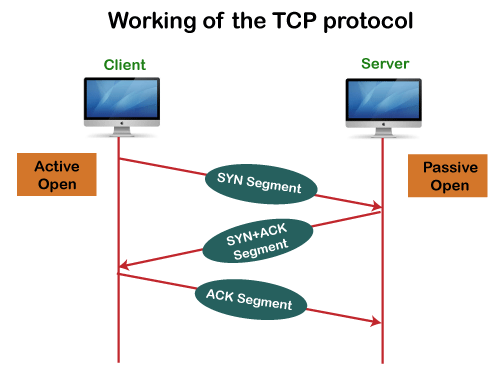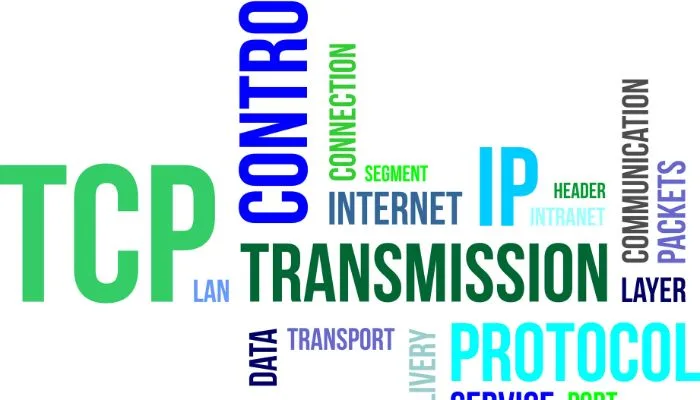What is TCP?
TCP stands for Transmission Control Protocol, which is one of the core protocols of the Internet Protocol Suite. It provides reliable, ordered, and error-checked delivery of data packets over a network. TCP is connection-oriented, meaning that it establishes a virtual connection between the sender and receiver before transmitting any data.
TCP (Transmission Control Protocol) and IP (Internet Protocol) are like a dynamic duo that makes sure our info gets from point A to point B without any problems. Let’s look more closely at how these two methods make the Internet what it is today.
In the vast world of computer networking, there is one protocol, called TCP, that stands out as the most effective way to send data. In their Request for Comment (RFC) standards document number 793, the Internet Engineering Task Force (IETF), a well-known group that shapes the infrastructure of the Internet, has carefully outlined TCP. This paper is a complete guide that explains the details and requirements of TCP. This makes sure that communication is smooth across the digital landscape. Let’s learn more about TCP and what it means in the field of network engineering.
How Transmission Control Protocol works
The Transmission Control Protocol (TCP) handshake is the procedure by which two devices establish a connection in order to exchange data over a network. It’s a handshake in which two devices confirm each other’s availability and readiness by exchanging control messages. When the link is made, the gadgets can share information with one another.
It functions at the transport layer of the OSI model and is crucial to ensuring that data is transmitted between devices on a network without interruption or corruption. TCP is able to maintain its stability thanks to several different systems, including:

- Connection is established between sender and recipient via a three-way handshake before data transfer can commence.
- TCP assigns a unique number to each data packet, ensuring that they will be reassembled into the correct sequence once they have been received.
- Data packets are acknowledged once received, and any lost or damaged packets are resent.
What TCP is used for
- Reliable Data Transfer: TCP ensures the reliable transfer of data between devices over a network. It’s the go-to protocol for applications that require error-free and ordered data delivery. When you send an email, browse a website, or download a file, TCP is at work behind the scenes, ensuring that the data arrives intact and in the correct order.
- Web Browsing: When you open your web browser and access a website, TCP is responsible for fetching and displaying web pages accurately. It guarantees that all the elements of a webpage, from text to images, load correctly on your screen.
- Email Communication: SMTP (Simple Mail Transfer Protocol) relies on TCP for sending and receiving emails. TCP ensures that your emails reach their intended recipients without errors or omissions.
- File Transfer: If you’ve ever used FTP (File Transfer Protocol) or its secure counterpart, SFTP (Secure File Transfer Protocol), you’ve benefited from TCP’s reliability. These protocols use TCP to transfer files securely between computers.
- Remote Desktop: TCP plays a pivotal role in remote desktop applications like RDP (Remote Desktop Protocol). It ensures that your interactions with a remote computer are smooth and responsive.
Application of TCP
- Internet Communication: TCP is the main way that people talk to each other over the Internet. TCP makes sure that data is sent smoothly and without mistakes when you visit websites, send emails, or chat online. It’s the reason you can easily view web content and talk to people all over the world.
- E-commerce: TCP makes it possible to do business online in a safe way. When you make purchases or financial transactions online, TCP makes sure that your orders are processed correctly and that private information, like your credit card number, is kept safe.
- TCP is an important part of talk over IP (VoIP) and video conferencing in the field of telecommunications. It makes sure that audio and video data packets are sent in the right order so that delays are kept to a minimum and contact goes smoothly.
- Content Delivery: TCP is used by content delivery networks (CDN) to send out web information quickly. TCP makes sure that users get their data smoothly and without errors, whether they are streaming videos, downloading software updates, or opening big files.
- Cloud Services: TCP is used to send data between clients and remote computers in cloud computing. TCP makes sure that data is sent safely and in the right order, whether you’re saving data in the cloud, using cloud-based apps, or making backups.
- Remote Access: Many tools and protocols for remote access, like SSH (Secure Shell), Telnet, and RDP (Remote Desktop Protocol), use TCP to make links that are safe and quick. It makes sure that you can safely connect to faraway computers or servers.
TCP vs. UDP
TCP is often compared to UDP (User Datagram Protocol), another core protocol of the Internet Protocol Suite. While TCP provides reliable and ordered transmission, UDP offers a connectionless and unreliable transmission. TCP is suitable for applications that prioritize data integrity and reliability, while UDP is preferred for real-time applications that prioritize speed and low latency.
| Feature | TCP | UDP |
|---|---|---|
| Reliability | Highly reliable, ensures data delivery without loss or corruption. | Unreliable, data delivery is not guaranteed, and packets may be lost or received out of order. |
| Ordering | Orders data packets, ensuring they are received in the correct sequence. | Does not guarantee packet order; packets may be received out of order. |
| Error Checking | Includes error-checking mechanisms to detect and correct packet errors. | Provides minimal error checking; errors must be handled by the application layer if needed. |
| Overhead | Has higher overhead due to additional control data for reliability and sequencing. | Has lower overhead, making it faster for real-time applications. |
| Speed | Slower compared to UDP due to reliability mechanisms. | Faster due to minimal overhead, suitable for real-time applications like streaming. |
| Suitable For | Ideal for applications where data accuracy and order are critical, such as web browsing, email, and file transfers. | Preferred for real-time applications like online gaming, VoIP, and live video streaming, where speed is more important than guaranteed delivery. |
| Examples | HTTP, FTP, SMTP, HTTPS | DNS, VoIP (voice over IP), online gaming (excluding critical game data), streaming media. |
TCP vs. IP: What is the Difference?
Although TCP and IP (Internet Protocol) are often mentioned together, they serve different functions. TCP is responsible for the reliable transmission of data, while IP is responsible for addressing and routing the data packets across the network. In simple terms, TCP ensures that the data reaches its destination accurately, while IP ensures that the data reaches the correct destination.
| Feature | TCP | IP |
|---|---|---|
| Layer in Protocol Stack | Operates at the Transport Layer of the OSI model. | Operates at the Network Layer of the OSI model. |
| Function | Ensures reliable, ordered, and error-checked delivery of data between devices. | Responsible for routing packets of data so they can travel across networks and arrive at their intended destinations. |
| Reliability | Highly reliable, guarantees data delivery without loss or corruption. | Not designed for reliability; its primary function is routing and addressing. |
| Ordering | Orders data packets, ensuring they are received in the correct sequence. | Does not ensure packet order; packets may be routed through different paths and arrive out of order. |
| Error Checking | Includes error-checking mechanisms to detect and correct packet errors. | Provides minimal error checking, primarily focused on addressing and routing. |
| Connection | Highly reliable, and guarantees data delivery without loss or corruption. | Connectionless protocol, data packets are sent independently without establishing a connection. |
| Header Size | Has a larger header size due to control data for reliability and sequencing. | Has a smaller header size, focusing on source and destination IP addresses. |
| Use Cases | Ideal for applications where data accuracy and order are critical, such as web browsing, email, and file transfers. | Essential for routing data across networks and ensuring it reaches the correct destination. |
| Examples | HTTP, FTP, SMTP, HTTPS | IPv4, IPv6 |
Why TCP is important
TCP plays a crucial role in ensuring the robustness and reliability of Internet communication. By providing error-checking, flow control, and congestion control mechanisms, TCP enables data to be transmitted accurately and efficiently across networks. Without TCP, the Internet as we know it today would not be possible.
TCP’s importance lies in its ability to guarantee data reliability, order, and integrity, making it the protocol of choice for numerous critical networking applications.
- Reliability: TCP guarantees data arrives intact and in the correct order, crucial for many applications.
- Error Recovery: It detects and retransmits lost or corrupted packets, maintaining data integrity.
- Flow Control: TCP prevents network congestion and ensures efficient data transfer.
- Widespread Use: TCP is the foundation of Internet communication, making it indispensable.
Advantages and Disadvantages of TCP
Advantages of TCP
- Reliability: TCP guarantees the delivery of data, ensuring that no packets are lost or corrupted during transmission.
- Ordered delivery: TCP ensures that data packets are received and assembled in the same order they were sent.
- Error-checking: TCP uses checksums to detect and correct errors in data transmission.
Disadvantages of TCP
- Overhead: TCP requires additional overhead to establish and maintain connections, which can impact performance.
- Slower than UDP: Due to its reliability mechanisms, TCP is generally slower than UDP.

